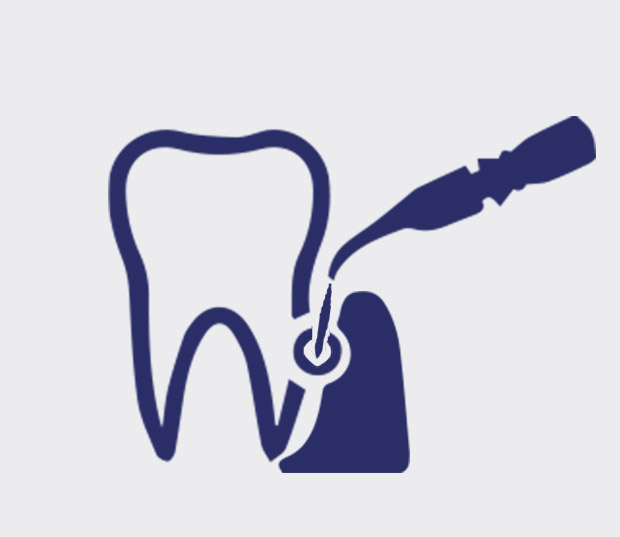
Laser applications in dentistry
تاریخ: ۲۳ آذر ۱۳۹۹ dr etemadifar
What is meant by laser in dentistry?
استفاده از لیزر در دندانپزشکی به طور بالقوه گزینه درمانی بهتری برای بسیاری از درمانهای دندانپزشکی شامل بافت سخت یا نرم ، نسبت به مته ها و سایر ابزارهای غیر لیزر می باشد.
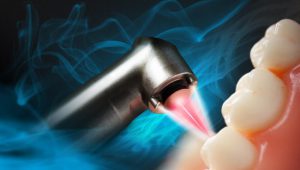
LASER stands for “light amplification by the stimulated emission of radiation.” The instrument creates light energy in a very narrow and focused beam. This laser light produces a reaction when it hits tissue, allowing it to remove or shape the tissue.
این نور لیزر هنگام برخورد با بافت ، واکنشی ایجاد می کند و به آن اجازه می دهد بافت را از بین ببرد یا به آن شکل دهد.
What has now entered the dental market as lasers are red and infrared wavelengths. These wavelengths are safe and do not pose a risk of genetic mutations or carcinogenesis.
Laser dentistry is used in a variety of procedures, including:
- treating hypersensitivity
- treating tooth decay
- treat gum disease
- whitening teeth
Types of lasers in dentistry
Depending on the type of treatment, dental professionals use soft tissue lasers or hard tissue lasers.
Hard tissue lasers can cut through tooth structure. Their wavelengths are absorbed through the combination of water and a specific mineral found in teeth. These lasers are most often used to prep or shape teeth for composite bonding, to repair dental fillings that have worn down, and to remove some tooth structure. . ، برای ترمیم و پرکردن دندانهای فرسوده و از بین بردن ساختار دندان استفاده می شوند.
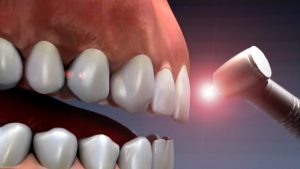
How are laser treatments performed?
The two main types of procedures used for laser dentistry are hard tissue and soft tissue procedures. Hard tissue refers to the teeth, and soft tissue refers to the gums.
Common hard tissue procedures include:
- Cavity detection Lasers can detect cavities early by finding evidence of tooth decay.
- Tooth preparations and dental fillings: Local anesthesia and traditional drills are often not needed with laser treatments. Lasers can kill bacteria in a cavity, which can aid in the long-term health of a tooth.
- Treating tooth sensitivity Teeth that have sensitivity to hot and cold can be treated with dental lasers that seal tubules on the tooth’s root.
Common soft tissue procedures include
- treat gummy smile: Lasers are used to reshape gum tissue associated with “gummy smile,” in which the gums’ length covers much of the tooth.
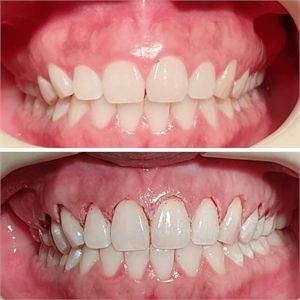
- Crown lengthening.: . reshapes gum tissue This procedure reshapes both gum tissue and bone for healthier tooth structure, which helps with placing restorations on the teeth.
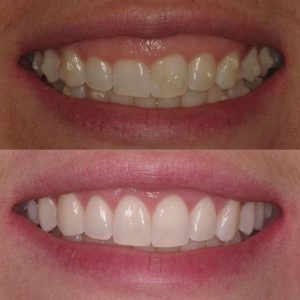
- Treating tongue frenulum attachment. Those with a thick or tight frenulum (the fold of skin under the front part of tongue that anchors to the mouth floor) may benefit from a laser frenectomy. This treatment helps children whose restricted frenulum causes them to be tongue-tied, have difficulty breastfeeding, or have a speech impediment.
- Removing soft tissue folds Lasers can remove soft tissue folds from ill-fitting dentures without pain or sutures.
Other laser procedures include:
- Viewing tissues Optical coherence tomography allows a doctor to safely see inside a tooth or gum tissue.
- Removing benign tumors Lasers can remove tumors from the palate, gums, and sides of the lips and cheeks through a pain- and suture-free method.
- Treating obstructive sleep apnea Lasers can reshape the throat and relieve associated breathing problems when sleep apnea is caused by tissue overgrowth in the throat.
- TMJ (temporomandibular joint) treatment Lasers can help reduce pain and inflammation in the joint.
- Nerve regeneration Lasers can help regenerate damaged blood vessels, nerves, and scars.
- Treating cold sores Lasers can minimize healing time and reduce pain from cold sores.
- Teeth whitening: استفاده از لیزر جهت تسریع فرایند بلیچینگ در مطب ( office bleaching) است.در فرآیندهایی مثل بلچینگ دندان در مطب، که فرآیندی سخت و زمان بر است، لیزر دندان بسیار کمک کننده است ، یعنی یک فرایند ۲ ساعته تقریبا با ده دقیقه درمان لیزری به پایان میرسد.
Laser treatments may be cheaper than non-laser treatments because laser treatment is usually done in fewer sessions.
- Tooth denervation or root canal treatment with laser That the laser helps to disinfect more channels. And especially in infected teeth where bacteria have penetrated deep into the dentin and we can't get to these points with any detergent, dental lasers help us. So laser denervation does not mean the whole process of laser root canal treatment. But lasers are very helpful in this process.
- Teeth cleaning with laser After scaling with ultrasonic or piezoelectric devices, we can disinfect the mass in a very effective and completely safe way with dental lasers.
-
Use of laser for Removal of gingival discoloration (Gingival depigmentation)
Some people have pigments in their gums that make their gums darker, and in some cases the darkening of the gums plays a big role in a person's appearance. These pigments accumulate in the surface layers of the gums, and on the other hand, smoking. Many cases, with the penetration of nicotine and circular amines deep into the gums, cause more pigments to be produced. For this reason, this problem is more pronounced in smokers. But diode and erbium lasers can help prevent these pigments from forming in the gums. Although recurrence is possible, recurrence does not necessarily occur.
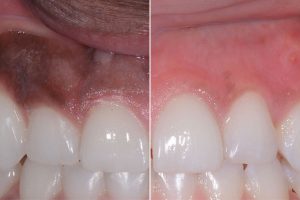
- Laser application in Implant :
The fact is that currently the only laser that can remove and dissect a bone is an erbium laser. And unfortunately, bone cutting for implants with this laser still can't be done accurately. Certainly in the coming years, with the advancement of laser devices, this feature will enter dental lasers. However, the use of lasers in dental implants is still not small. The laser can significantly help disinfect the implant site. In many cases, using a laser in the first two weeks after a dental implant can help stimulate bone marrow cells. In many cases, postoperative inflammation is reduced, and sometimes we can use soft tissue laser devices in the second session of dental implant surgery, which is based solely on the gums.
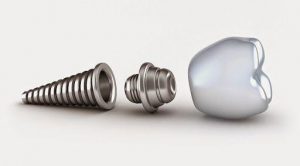
- The use of lasers in the treatment of pests
آفت دهان، یک ضایعه دردناک داخل دهانی است که علت بروز آن هنوز کاملا مشخص نیست. اما به هرحال تنها روش هایی که در حال حاضر برای درمان آفت دهان وجود دارد، درمان با کورتونهاست. که یک درمان ۵ تا ۷ روزه هست. اما لیزرهای کم توان ، میتوانند طی دو تا سه جلسه درمانی کوتاه بافاصله ۴۸ ساعت در فاصله ۴ روز آفت دهان شما را ازبین ببرد و حتی ادعا شده که احتمال عود را هم شدیدا پایین می آورد. این خبر خوبی است برای کسانی که از آفتهای مکرر در دهانشان شکایتمندند.
- Laser application in the treatment of herpes lesions (laser mole treatment):
When the herpes zoster is vesicular (fresh and ripe), the entire lesion can be removed with powerful lasers, and it is believed that both the infectious burden of the lesion is reduced and the likelihood of recurrence in the same area is reduced. When it comes to shelling, we can speed up repair with the help of low-power lasers.
Benefits of using laser dentistry over other methods
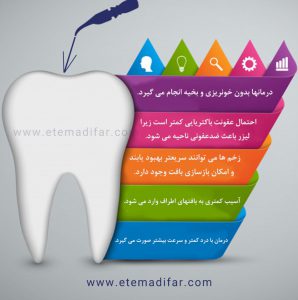
- There is potentially a decreased need for sutures with soft tissue lasers.
- Bleeding is minimized in treated soft tissues, as the laser promotes blood clotting.
- With some procedures, anesthesia is unnecessary.
- The chance for bacterial infections is lower because the laser sterilizes the area.
- Wounds can heal faster, and it’s possible for tissue to regenerate
- The procedures may involve less damage to the surrounding tissues
Disadvantages of laser dentistry
- Certain procedures can’t be done with laser treatment, depending on the preexisting surrounding tissue or components involving the tooth or gums.
- Lasers can’t be used on teeth that already have certain types of filling, such as metal amalgam.
- Some laser procedures still require anesthesia.

